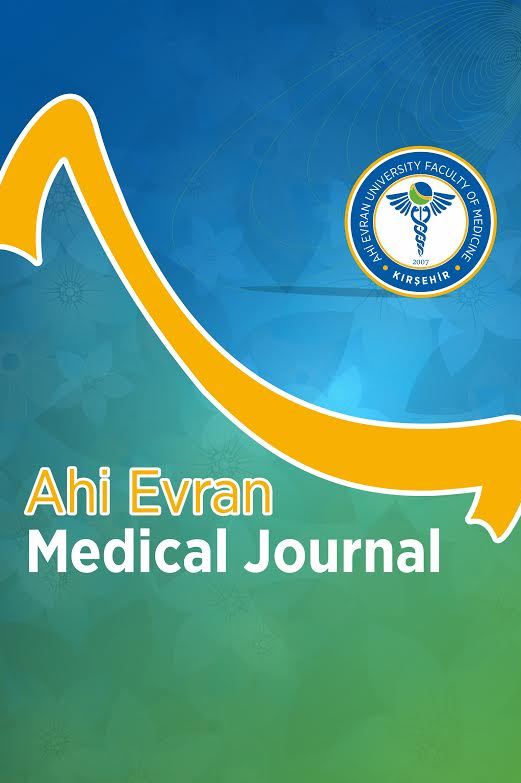Bezmialem Vakıf Üniversitesi Tıp Fakültesi 4. 5. ve 6. Sınıf Öğrencilerin Kardiyopulmoner Resüsitasyon Bilgilerinin Yeterlilik Araştırması
Kardiyopulmoner Resüsitasyon, Yeterlilik, Tıp Fakültesi öğrencileri
Cardiopulmonary Resuscitation Knowledge Competence among 4th, 5th, and 6th Grade Students of Bezmialem Vakif University Faculty of Medicine
Cardiopulmonary Resuscitation, Knowledge, Student,
___
- 1. Kleinman ME, Brennan EE, Goldberger ZD, et al. Part 5: adult basic life support and cardiopulmonary resuscitation quality: 2015 American Heart Association guidelines update for cardiopulmonary resuscitation and emergency cardiovascular care. Circulation. 2015;132(18 Suppl 2):S414–S435.
- 2. Perkins GD, Travers AH, Berg RA, et al. Part 3: adult basic life support and automated external defibrillation: 2015 International Consensus on Cardiopulmonary Resuscitation and Emergency Cardiovascular Care Science with Treatment Recommendations. Resuscitation. 2015;95:e43–e69.
- 3. Neumar RW, Shuster M, Callaway CW, et al. Part 1: executive summary: 2015 American Heart Association guidelines update for cardiopulmonary resuscitation and emergency cardiovascular care. Circulation. 2015;132(2):315-367.
- 4. Kong MH, Fonarow GC, Peterson ED, et al. Systematic review of the incidence of sudden cardiac death in the United States. J Am Coll Cardiol. 2011;57(7):794–801.
- 5. Andrew HT, Thomas DR, Bentley JB, et al. Guidelines 2010 for Cardiopulmonary Resuscitation and Emergency Cardiovascular Care Science: CPR Overview. Circulation. 2010;122(18 Suppl 3):S676-S684.
- 6. Kaan MN, Kurt İ, Gürsoy F. Üniversite hastanesinde temel yaşam desteği ve defibrilasyon kursu sonuçlarının değerlendirilmesi. ADÜ Tıp Fakültesi Dergisi. 2010;11(3):1-7.
- 7. Yılmaz A, Sabırlı R, Seyit M, Özen M. Temel Yaşam Desteği Eğitimi Alan Tıp Fakültesi Öğrencilerinin Bilgi ve Beceri Düzeyleri. Van Med J. 2019;26(3):324-330.,
- 8. Çalışkan N, Durukan P, Baykan N, Kaymaz ND, Elmalı F, Kaval C. Compliance to guidelines in in-hospital cardiopulmonary resuscitation interventions: single-center experience. Cukurova Med J. 2019;44(2):402-409.
- 9. Bilir Ö, Acemoğlu H, Aslan Ş, Çakır Z. Knowledge levels as to basic life support of medical doctors and affecting factors. Turk J Emerg Med. 2007;7(1):18–24.
- 10. Lerner EB, Rea TD, Bobrow BJ, et. al. American Heart Association Emergency Cardiovascular Care Committee; Council on Cardiopulmonary, Critical Care, Perioperative and Resuscitation. Emergency medical service dispatch cardiopulmonary resuscitation prearrival instructions to improve survival from out-of-hospital cardiac arrest: a scientific statement from the American Heart Association. Circulation. 2012;125(4):648–655.
- 11. Murt A. Tıp eğitimi: Ölçme ve değerlendirmede becerilerin değerlendirilmesi. Sağlık Düşüncesi ve Tıp Kültürü Dergisi. 2011;20:92–95.
- 12. Kutyifa V, Moss AJ, Klein H, et al. Use of the wearable cardioverter defibrillator in high-risk cardiac patients: data from the Prospective Registry of Patients Using the Wearable Cardioverter Defibrillator (WEARIT-II Registry). Circulation 2015;132(17):1613-1619.
- 13. Yoldaş H, Kocoğlu H, Bayır H, et al. Attitudes of Doctors Working in Abant Izzet Baysal University Health Research and Application Center on Cardiopulmonary Resuscitation. Turk J Anaesthesiol Reanim. 2016;44(3):142-148.
- 14. Sangamesh NC, Vidya KC, Pathi J, Singh A. Awereness, attitude, and knowledge of basic lide support among medical, dental, and nursing faculties and students in the universty hospital. J Int Soc Prev Community Dent. 2017;7(4):161-167.
- 15. Bielec G, Klajman P, et al. Effectiveness of basic life support instruction in physical education students – a pilot study. Teach Learn Med. 2014;26(3):252–257.
- 16. Alonso F, Lopez G, Manrique D, Vines JM. An instructional model for web-based e-learning education with a blended learning process approach. Br. J. Educ. Technol. 2005;36(2):217-235.
- 17. Göçgeldi E, İstanbulluoğlu H, Uçar M, Yaren H, Ceylan S, Koçak N. Tıp fakültesi 5 ve 6. sınıf öğrencilerinin tıp eğitimleri süresince pratik uygulama yapabilme durumunun araştırılması. Gülhane Tıp Derg. 2011;53(2):107-113.
- 18. Gürol A, Balcı Akpınar R, Ejder Apay S. Simulasyon Uygulamalarının Öğrencilerin Beceri Düzeylerine Etkisi. Kocatepe Tıp Derg. 2016;17(3):99-104.
- 19. Örsal Ö, Mert Boğa S, Kersu Ö. Acil ve yoğun bakım servislerinde çalışan hemşirelerin temel ve ileri kardiyak yaşam desteğine ilişkin bilgi düzeylerinin değerlendirilmesi. IGUSABDER. 2017;(3):203-220.
- 20. Çelikli S, Yıldırım GÖ, Ekşi A. Sağlık Personelinin Güncel Temel Yaşam Desteği Bilgilerinin Değerlendirilmesi. Tr J Emerg Med. 2012;12(3):129-133.
- 21. Kiyan S, Yanturali S, Musal B. Determination of advanced life support knowledge level of residents in a Turkish university hospital. J Emerg Med. 2008;35(2):213-222.
- 22. Lyng JW, White CC, Peterson TQ, et al. Non-auto-injector epinephrine administration by basic life support providers: A literature review and consensus process. Prehosp Emerg Care. 2019;23(6):855-861.
- 23. Sopka S, Biermann H, Druener S, et al. Practical skills training influences knowledge and attitude of dental students towards emergency medical care. Eur J Dent Educ. 2012;16(3):179-186.
- Yayın Aralığı: Yılda 3 Sayı
- Başlangıç: 2017
- Yayıncı: Kırşehir Ahi Evran Üniversitesi
Didrogesterona bağlı toksik hepatit: Olgu sunumu
Mustafa KAPLAN, Muhammet Yener AKPINAR, Orhan COŞKUN, Adem AKSOY, Volkan GÖKBULUT
Plantar Fasiit Tedavisinde Ekstrakorporeal Şok Dalga Tedavisinin Etkinliğinin Değerlendirilmesi
Senem ŞAŞ, Fatmanur Aybala KOÇAK
Hemşirelik Öğrencilerinin Sağlık Bakımında Bilgisayar Kullanımına Yönelik Tutumlarının İncelenmesi
Hülya BAYBEK, Arzu KIVRAK, Halime TOZAK YILDIZ, Merve ÇİFTÇİ
Bir Hemşirenin Kâbusu: Bir Yabancı Cisim Olarak Kol Veninde Bir İntavenöz Kateterin Yarısı
Süreyya TALAY, İbrahim ÖZCAN, Feray AYDIN
Selman GÜNDOĞAN, Bahadir TASLİDERE, Elmas BİBERCİ KESKİN
